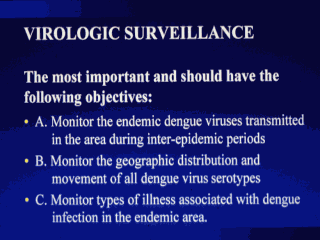Search inside of Supercourse and lectures in HTML and PPT format
|
|
|
|
front |1 |2 |3 |4 |5 |6 |7 |8 |9 |10 |11 |12 |13 |14 |15 |16 |17 |18 |19 |20 |21 |22 |23 |24 |25 |review |
 Virologic Surveillance: the most important and valid type of surveillance for predicting epidemic dengue. Virologic surveillance should have the following objectives: 1. Monitor the endemic dengue viruses transmitted in the area during inter-epidemic periods. 2. Monitor the geographic distribution and movement of all dengue virus serotypes. 3. Monitor types of illness associated with dengue infection in the endemic area. For maximum efficiency, the surveillance system must be adaptable to changes in disease incidence. As Aedes aegypti infestation increases, vector surveillance becomes important for prioritizing and stratifying areas for intervention and for monitoring the effect of control efforts; disease surveillance now becomes necessary in order to detect the introduction and transmission of dengue virus. Nevertheless, the aim of active virologic surveillance, the most important element, is to monitor dengue transmission, giving emphasis to periods of sporadic or silent transmission, so as to quickly detect introduction of new virus strains or serotypes. Nevertheless, the aim of active virologic surveillance, the most important element, is to monitor dengue transmission, giving emphasis to periods of sporadic or silent transmission, so as to quickly detect introduction of new virus strains or serotypes. Other important components are surveillance for increased fever activity and for viral syndromes with fatal outcomes. Individually, none of these components is necessarily very sensitive, but collectively the three together provide the most sensitive data obtainable for predicting epidemic dengue. Furthermore, when used in conjunction with entomologic data they provide the basis for action by a rapid response emergency vector control unit seeking to control an incipient epidemic before it spreads. However, it must be emphasized that effective surveillance for dengue and dengue hemorrhagic fever/dengue shock syndrome is not possible without a diagnostic laboratory that can perform serologic and virologic diagnostic tests that are both rapid and sensitive. This is a major problem in many dengue-endemic countries. |